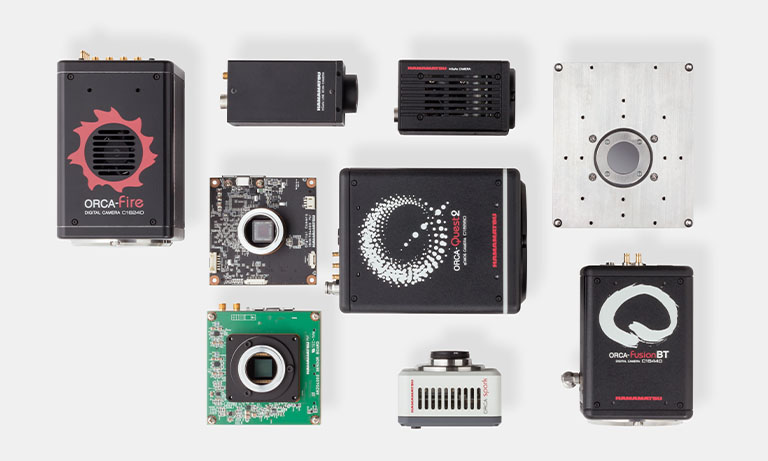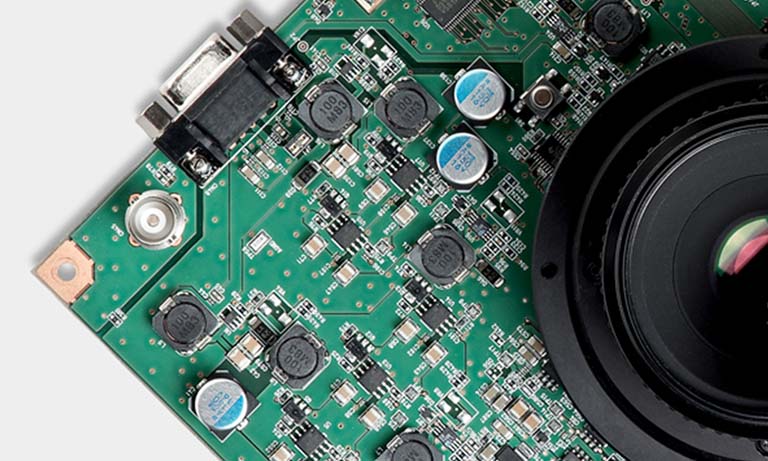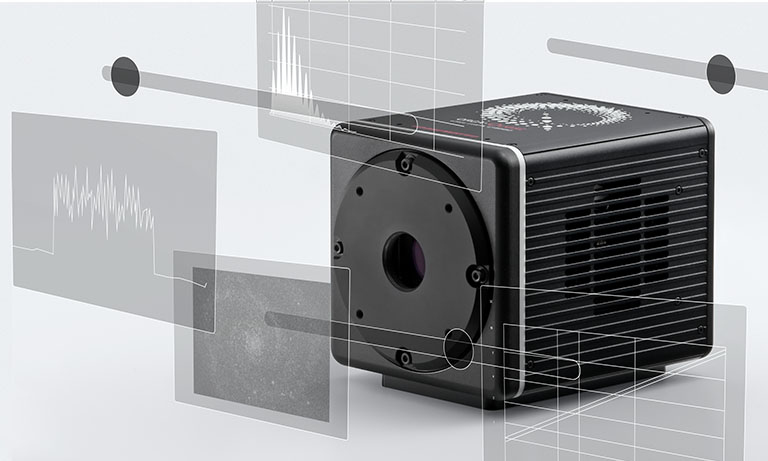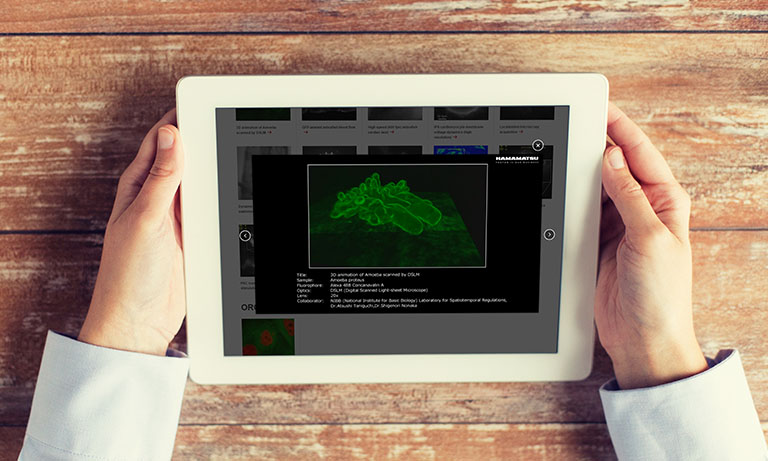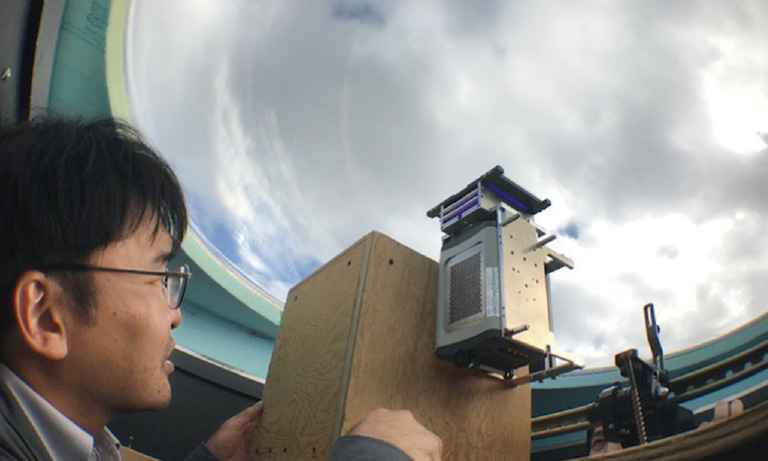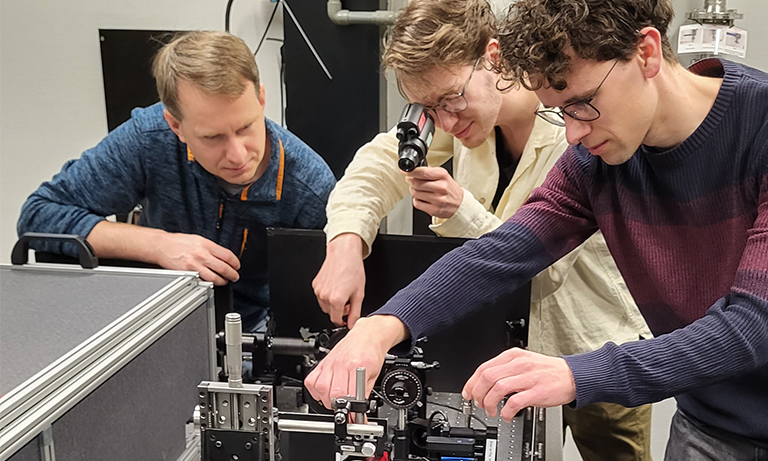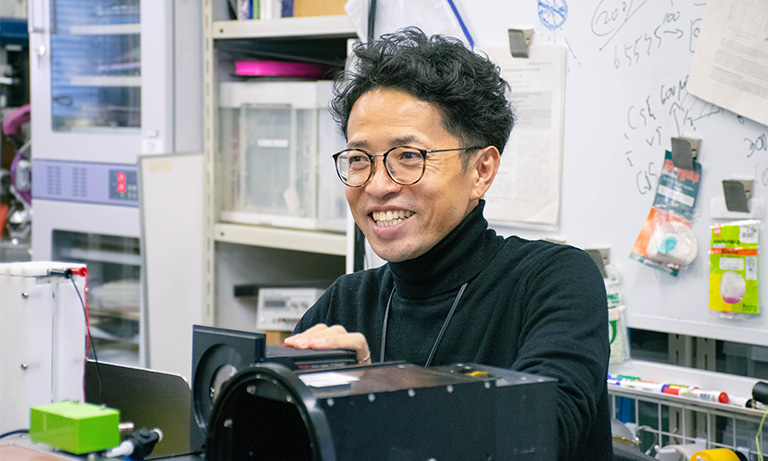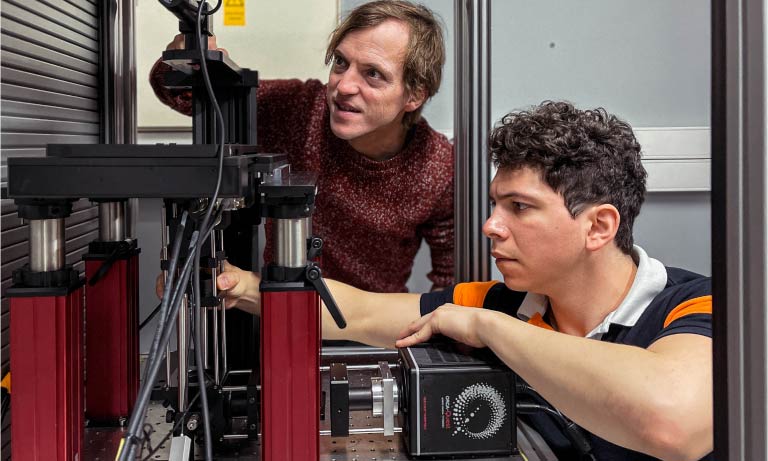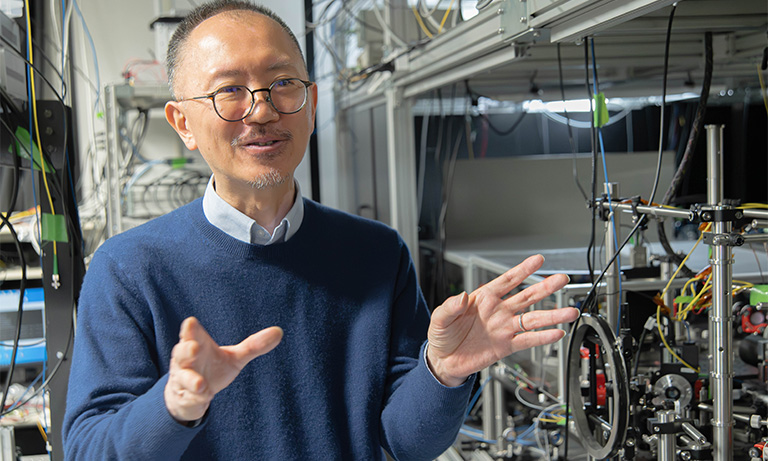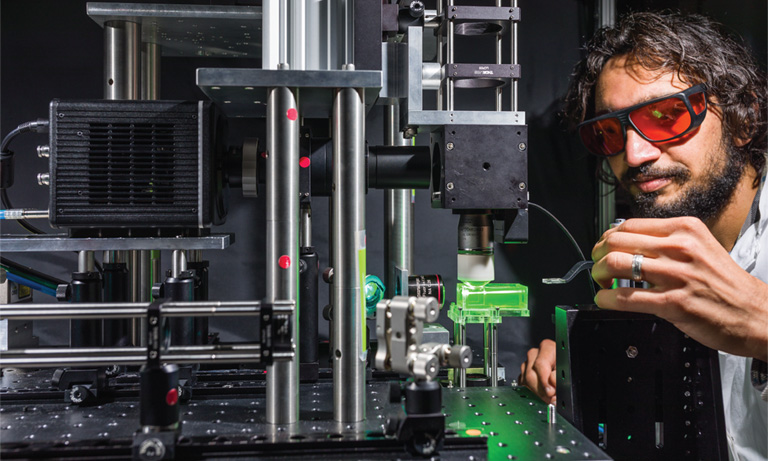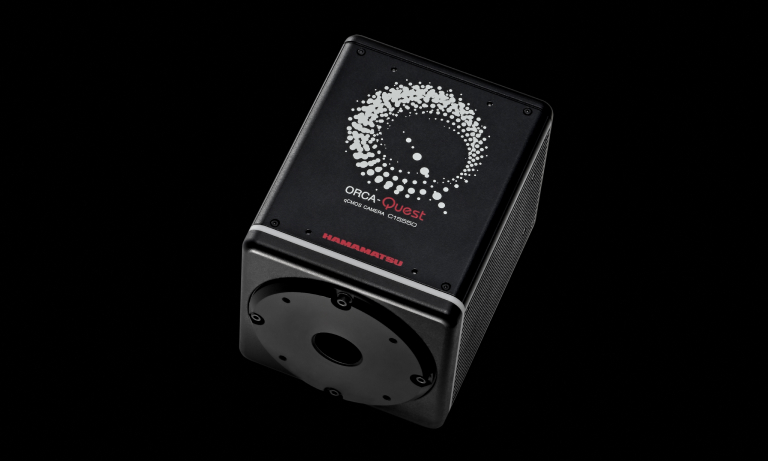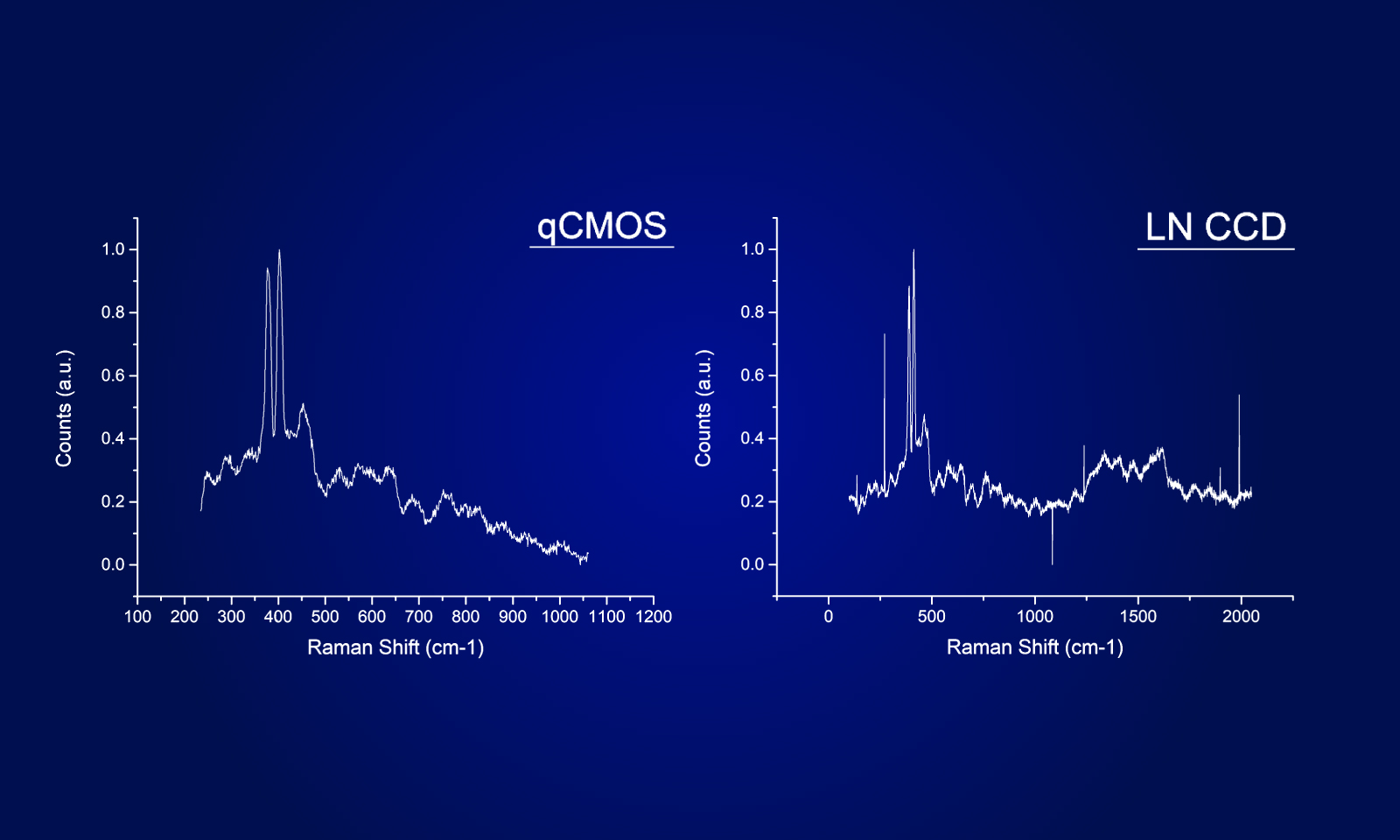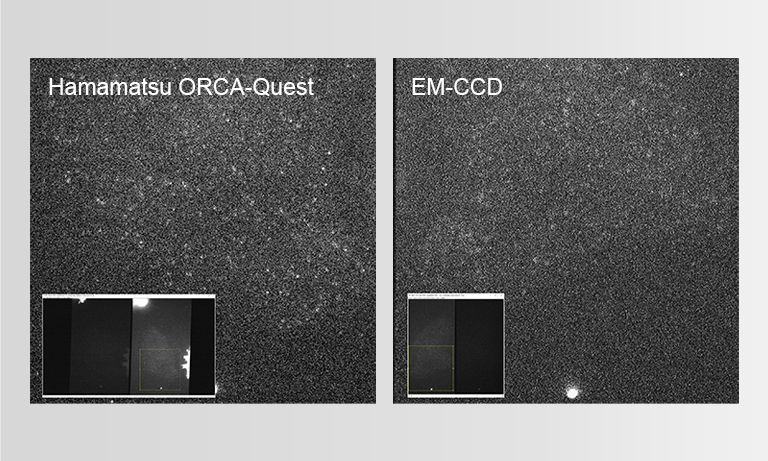Japan (JA)
国・地域を選択してください。
解像度はどのくらいか? 視野角はどのくらいか?
本ガイドの対象者 :
顕微鏡カメラを使用している、またはこれから使用したいと考えている研究者の方
本ガイドの内容 :
カメラのスペックと実験との関連性について説明します。
セクション :
仕様の表記について :
| 浜松ホトニクスの表記 | 他メーカーの表記 |
|---|---|
| 有効画素数 | Active pixels, Resolution |
| 画素サイズ | Pixel size |
| 有効素子サイズ | Image area, Active area, Sensor/diagonal |
視野 (Field of view)
カメラの仕様表を見ると、工学的観点から生物学的観点への翻訳だけでなく、カメラメーカーの言語から別の言語への翻訳が必要な場合があります。特に、どの程度の解像度が得られるかを説明する用語はその傾向が顕著です。
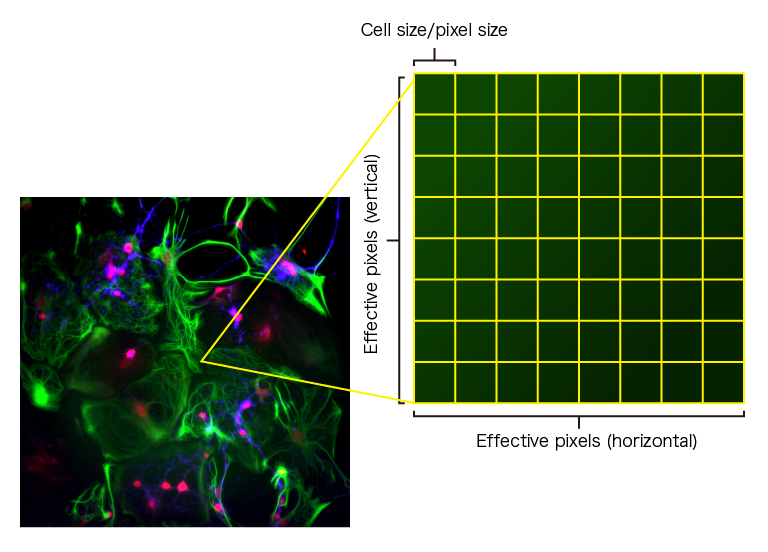
まず、有効画素数 (Effective pixel) という言葉について説明します。これは画像を撮影するための画素数のことを示しています。左図のように各画素を拡大すると正方形または長方形のグリッド状になっており、各画素は特定の領域で検出した光子を信号として出力します。
各画素がカバーする領域は、画素のサイズによって異なり、仕様表では画素サイズ (Pixel size) として記載されています。
画素サイズに画素数をかけると、1枚の画像に写る視野が画素数からミリメートルに変換され、有効素子サイズ (Effective sensor size) と表記されます。
画素数を単に画素数ではなく、有効画素数と表現するのはなぜでしょうか? カメラによっては、センサ上のすべての画素が画像に寄与するのではなく、光電子や電圧を伝達したり保持したりするために使用されるものもあるため、曖昧さを防ぐ表現を使用しています。
分解能
ピクセルサイズの規格は、カメラの分解能にどのように反映されるのでしょうか?
まず、光学系が分解能を制限することを念頭に置くことが重要です。顕微鏡がサンプルを分解できなければ、カメラも画像を見ることができません。そこで、まず顕微鏡の分解能を調べて、分解する対象物の投影像の大きさを算出します。そのためには、分解能を定義する必要があります。
では、分解能はどのように定義されているのでしょうか?
1873年、物理学者エルンスト・アッベ (Ernsr Abbe) は、対物レンズの回折限界をλ/2NAと初めて定義しました。その後、レイリーはこの式を顕微鏡用に改良し、0.61×λ/NA (2つのエアリーパターンを別の物体として見分けるのに必要な距離) としました。
このレイリー方程式から、対物レンズが解像できる最小のものの大きさを算出し、その数値に対物レンズの倍率 (中間光学系がないと仮定) をかけると、そのものがカメラのセンサに映ったときにどれくらいの大きさに見えるかを算出することができます。
この分解能を得るためには、どの程度の画素数が必要なのでしょうか?
光学系の分解能と物体の投影サイズが決まれば、その分解能を満たすために必要な最大許容画素サイズを決定することができます。物体を正確に定義するために必要な最小限の画素数に関する理論的枠組みであるナイキスト (Nyquist) 基準を満たす必要があるため、カメラセンサ上の少なくとも2つの画素に対象物体を確実に投影する必要があります (理想的にはそれ以上、高分解能顕微鏡では2.5~3が推奨されます) 。
例えば、直径約0.7μmのラット肝実質細胞のペルオキシソームを分解しようとする場合を考えてみます。0.7μmの物体を分解するためには、同等以上の分解能を持つ対物レンズが必要です。表1より、最低限必要な倍率は、倍率10倍、NA0.45の対物レンズとなります (もちろん、広い視野を必要としない場合、ほとんどの顕微鏡医は、より視覚的に美しく、情報量の多い画像を得るためにオーバーサンプリングして高倍率を使用します) 。この倍率では投影像が7.5μmになるので、7.5μm÷2=3.7μm以下の画素サイズのカメラが必要です。
| Table 1. | ||||
|---|---|---|---|---|
| 対物レンズ倍率 | 開口数 (NA) | δ*(=レイリー分解能) (μm) | Δ (=δ x 対物レンズ倍率) (μm) | 適正画素サイズ (μm) |
| 4 | 0.20 | 1.7 | 6.7 | 3.4 |
| 10 | 0.30 | 1.1 | 11.2 | 5.6 |
| 10 | 0.45 | 0.7 | 7.5 | 3.7 |
| 20 | 0.50 | 0.7 | 13.4 | 6.7 |
| 20 | 0.75 | 0.4 | 8.9 | 4.5 |
| 40 | 0.75 | 0.4 | 17.9 | 8.9 |
| 40 | 1.30 | 0.3 | 10.3 | 5.2 |
| 60 | 1.40 | 0.2 | 14.4 | 7.2 |
| 100 | 1.30 | 0.3 | 25.8 | 12.9 |
| 100 | 1.40 | 0.2 | 24.0 | 12.0 |
| *@550 nm | ||||
まとめ :
- カメラが実現できる視野は、各メーカーで有効画素数、有効素子サイズという言葉やそれに準ずるものに反映されています。
- 顕微鏡がサンプルを分解できなければ、カメラも分解できません。
- 顕微鏡が観察対象を分解できると判断した後は、カメラ側が十分な画素数で画像をサンプリングできているかどうかを判断する必要があります。
- カメラがサンプリングの必要性を満たせるかどうかを判断する場合、投影される画像サイズが2ピクセル以上に及ぶ(つまり、3ピクセルの少なくとも一部に触れる)ことを確認します。
- Confirmation
-
It looks like you're in the . If this is not your location, please select the correct region or country below.
You're headed to Hamamatsu Photonics website for JP (Japanese). If you want to view an other country's site, the optimized information will be provided by selecting options below.
In order to use this website comfortably, we use cookies. For cookie details please see our cookie policy.
- Cookie Policy
-
This website or its third-party tools use cookies, which are necessary to its functioning and required to achieve the purposes illustrated in this cookie policy. By closing the cookie warning banner, scrolling the page, clicking a link or continuing to browse otherwise, you agree to the use of cookies.
Hamamatsu uses cookies in order to enhance your experience on our website and ensure that our website functions.
You can visit this page at any time to learn more about cookies, get the most up to date information on how we use cookies and manage your cookie settings. We will not use cookies for any purpose other than the ones stated, but please note that we reserve the right to update our cookies.
1. What are cookies?
For modern websites to work according to visitor’s expectations, they need to collect certain basic information about visitors. To do this, a site will create small text files which are placed on visitor’s devices (computer or mobile) - these files are known as cookies when you access a website. Cookies are used in order to make websites function and work efficiently. Cookies are uniquely assigned to each visitor and can only be read by a web server in the domain that issued the cookie to the visitor. Cookies cannot be used to run programs or deliver viruses to a visitor’s device.
Cookies do various jobs which make the visitor’s experience of the internet much smoother and more interactive. For instance, cookies are used to remember the visitor’s preferences on sites they visit often, to remember language preference and to help navigate between pages more efficiently. Much, though not all, of the data collected is anonymous, though some of it is designed to detect browsing patterns and approximate geographical location to improve the visitor experience.
Certain type of cookies may require the data subject’s consent before storing them on the computer.
2. What are the different types of cookies?
This website uses two types of cookies:
- First party cookies. For our website, the first party cookies are controlled and maintained by Hamamatsu. No other parties have access to these cookies.
- Third party cookies. These cookies are implemented by organizations outside Hamamatsu. We do not have access to the data in these cookies, but we use these cookies to improve the overall website experience.
3. How do we use cookies?
This website uses cookies for following purposes:
- Certain cookies are necessary for our website to function. These are strictly necessary cookies and are required to enable website access, support navigation or provide relevant content. These cookies direct you to the correct region or country, and support security and ecommerce. Strictly necessary cookies also enforce your privacy preferences. Without these strictly necessary cookies, much of our website will not function.
- Analytics cookies are used to track website usage. This data enables us to improve our website usability, performance and website administration. In our analytics cookies, we do not store any personal identifying information.
- Functionality cookies. These are used to recognize you when you return to our website. This enables us to personalize our content for you, greet you by name and remember your preferences (for example, your choice of language or region).
- These cookies record your visit to our website, the pages you have visited and the links you have followed. We will use this information to make our website and the advertising displayed on it more relevant to your interests. We may also share this information with third parties for this purpose.
Cookies help us help you. Through the use of cookies, we learn what is important to our visitors and we develop and enhance website content and functionality to support your experience. Much of our website can be accessed if cookies are disabled, however certain website functions may not work. And, we believe your current and future visits will be enhanced if cookies are enabled.
4. Which cookies do we use?
There are two ways to manage cookie preferences.
- You can set your cookie preferences on your device or in your browser.
- You can set your cookie preferences at the website level.
If you don’t want to receive cookies, you can modify your browser so that it notifies you when cookies are sent to it or you can refuse cookies altogether. You can also delete cookies that have already been set.
If you wish to restrict or block web browser cookies which are set on your device then you can do this through your browser settings; the Help function within your browser should tell you how. Alternatively, you may wish to visit www.aboutcookies.org, which contains comprehensive information on how to do this on a wide variety of desktop browsers.
5. What are Internet tags and how do we use them with cookies?
Occasionally, we may use internet tags (also known as action tags, single-pixel GIFs, clear GIFs, invisible GIFs and 1-by-1 GIFs) at this site and may deploy these tags/cookies through a third-party advertising partner or a web analytical service partner which may be located and store the respective information (including your IP-address) in a foreign country. These tags/cookies are placed on both online advertisements that bring users to this site and on different pages of this site. We use this technology to measure the visitors' responses to our sites and the effectiveness of our advertising campaigns (including how many times a page is opened and which information is consulted) as well as to evaluate your use of this website. The third-party partner or the web analytical service partner may be able to collect data about visitors to our and other sites because of these internet tags/cookies, may compose reports regarding the website’s activity for us and may provide further services which are related to the use of the website and the internet. They may provide such information to other parties if there is a legal requirement that they do so, or if they hire the other parties to process information on their behalf.
If you would like more information about web tags and cookies associated with on-line advertising or to opt-out of third-party collection of this information, please visit the Network Advertising Initiative website http://www.networkadvertising.org.
6. Analytics and Advertisement Cookies
We use third-party cookies (such as Google Analytics) to track visitors on our website, to get reports about how visitors use the website and to inform, optimize and serve ads based on someone's past visits to our website.
You may opt-out of Google Analytics cookies by the websites provided by Google:
https://tools.google.com/dlpage/gaoptout?hl=en
As provided in this Privacy Policy (Article 5), you can learn more about opt-out cookies by the website provided by Network Advertising Initiative:
http://www.networkadvertising.org
We inform you that in such case you will not be able to wholly use all functions of our website.
Close
